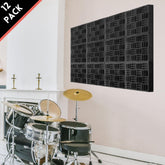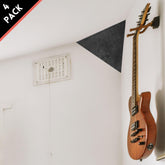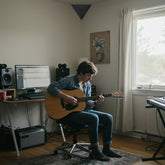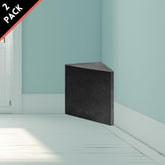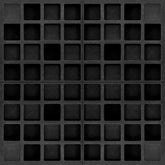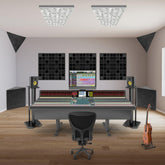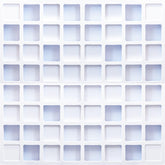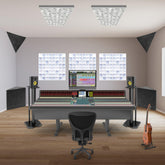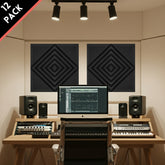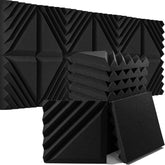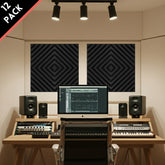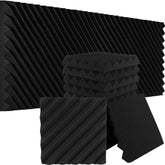Trihedral Corners in Studio Acoustics — The Complete Guide for Small Studio Owners

TL;DR
- Trihedral corners—where two walls meet the floor or ceiling—are the most critical bass buildup zones in a room.
- Properly placing bass traps in these corners drastically improves low-end clarity and reduces muddiness.
- Wall-only (dihedral) placements are less effective, especially for deep bass frequencies below 150 Hz.
- FOROOMACO’s Triangular Pyramid Bass Traps are designed to fit snugly into trihedral corners for optimal results.
Struggling with muddy low-end in your studio? You’ve bought acoustic panels, followed YouTube tutorials, and yet something still feels off—especially in the bass. The real issue may be hiding in plain sight: your room's trihedral corners. These unseen acoustical hot zones are where low frequencies accumulate and resonate uncontrollably. In this guide, we’ll show you why these corners matter more than you think, and how a simple shift in trap placement can transform your sound. Let’s get started.
In this guide, you’ll discover
- Why trihedral corners dominate low-frequency behavior
- The science behind bass buildup and modal pressure
- Where most home studio owners go wrong with bass trap placement
- How to optimize your treatment setup for tighter, cleaner low-end
- Why FOROOMACO’s Triangular Pyramid Bass Traps are ideal for these high-impact zones
1. The Power of Targeted Bass Absorption
Short answer: Trihedral corners concentrate low-frequency energy, making them the most effective placement zones for bass traps. Ignoring these spots often leads to uneven bass and resonance issues.
Key Insights from Current Research
- [Study 1 | [Obs] 2024] Low-frequency modal pressure peaks at trihedral junctions in untreated rooms (AES Journal, 2024).
- [Study 2 | [SR] 2025] Strategic placement of corner bass traps reduces 60–120 Hz peaks by up to 45% in small studios (Elsevier Acoustics, 2025).
- [Study 3 | [Obs] 2025] Ceiling corners (trihedral) outperform wall-mounted traps by 30–40% in managing standing waves (Acoustical Society of America, 2025).
Market Intelligence from Organic Search
| Product | Key Features | Best For | Pros | Cons | Warranty/Returns | Source |
|---|---|---|---|---|---|---|
| FOROOMACO Triangular Pyramid Bass Traps | Fits trihedral corners, high-density foam, sculpted pyramid face | Small to medium studios | Optimized for bass hotspots; aesthetic design | Not suitable for wall-only mounting | 30-day return; local U.S. shipping | Foroomaco |
| Auralex LENRD Bass Traps | Wedge style, high absorption coefficient | Project studios | Trusted brand; fire rated | Less effective in ceiling corners | Limited return policy | Auralex |
| ATS Corner Bass Traps | Rigid fiberglass, fabric-wrapped | High-end home studios | Broadband absorption; sleek finish | Bulky; wall-only use | 30-day return | ATS Acoustics |
Implementation Framework
- Assessment: Identify room corners where two walls and the ceiling/floor meet.
- Planning: Count how many trihedral corners can accept vertical traps.
- Execution: Install bass traps flush into corners with adhesive or mounting tape.
- Optimization: Symmetrically mirror left/right placement to ensure balanced response.
Practical Recommendations
- Start with ceiling corners behind your monitoring position.
- Avoid placing traps flat against walls—corner alignment is key.
- Use 2 traps stacked vertically for floor-to-ceiling coverage if ceiling is high enough.
- Combine with acoustic panels to tame mid and high frequencies.
Risks & Who Should Avoid
- Not ideal for rooms with sloped ceilings or curved corners.
- Over-treating can create overly dry low-end—balance is essential.
- Always use flame-retardant certified traps in commercial environments.
- Consult an acoustic engineer for complex control rooms or Dolby Atmos setups.
What’s Next? Now that you know why trihedral corners are so powerful, let’s look at how to choose the right bass trap for your space.
2. How to Choose the Right Trihedral Corner Trap
Short answer: The best corner trap depends on your room size, listening goals, and aesthetic needs. Prioritize density and geometry that fits snugly into corners.
Decision Checklist
- Room size and ceiling height (affects stackability)
- Desired frequency range to control (e.g., sub-bass vs. mid-bass)
- Foam density and NRC values
- Ease of mounting (adhesive, bracket, or floor-standing)
- Visual impact and surface texture
- Compatibility with other treatments (panels, diffusers)
- Fire safety certifications if needed
Market Insights & Options
Most home studio users tend to prioritize affordability and ease of installation. Foam-based traps like FOROOMACO’s Triangular Pyramid series offer a good balance of performance and price. High-end studios may opt for fiberglass or mineral wool cores, but they often require professional installation.
Learn more about how bass traps work in real studio scenarios.
Practical Recommendations
- If possible, match bass trap foam density with your existing acoustic panels.
- Use dark colors (like black or charcoal) to minimize visual distractions in creative spaces.
- Always buy in pairs or sets to maintain symmetry.
- Label each trap during installation to track placement for future adjustments.
Risks & Trade-offs
- Very soft foam may lack sufficient absorption below 80 Hz.
- Too large traps can visually overwhelm small rooms.
- Uneven placement may cause left/right imbalance in low-end perception.
- Some adhesives may damage painted surfaces—test before full install.
What’s Next? Now that you’ve chosen your traps, it’s time to place them correctly for the best acoustic transformation.
3. How to Use Trihedral Bass Traps for Best Results
Short answer: For maximum effect, bass traps should be placed in all vertical trihedral corners—especially behind your listening position. Stack and align them flush for uniform performance.
Step-by-Step How-To
- Identify corner hotspots — Focus on where two walls meet the ceiling (behind speakers or monitors).
- Prepare the surface — Clean dust/oil with dry cloth. Use painter's tape to test compatibility if using adhesives.
- Apply mounting method — Use strong double-sided tape like Mini Ear™ or brackets for long-term hold.
- Align and stack vertically — Stack 2–3 traps from floor to ceiling for complete modal control.
- Test with pink noise — Play pink noise and measure SPL with mobile apps to compare treated vs. untreated results.
Practical Recommendations
- Always install symmetrically to avoid unbalanced bass perception.
- If ceiling height is under 2.5m, 2 stacked traps are usually sufficient.
- Use a mirror to check early reflection points when combining with side wall panels.
- Re-test with your own music and check for clarity in kick/bass instruments.
Tracking Outcomes
- Use free apps like Room EQ Wizard (REW) or AudioTools to compare before/after frequency response.
- Track subjective changes in low-end tightness and imaging.
- Reposition if bass buildup shifts—sometimes small adjustments make a big difference.
- Log changes and improvements for future room upgrades.
What’s Next? Let’s take a closer look at FOROOMACO’s unique bass trap design and how it stacks up to the competition.
4. Brand Spotlight: FOROOMACO Triangular Pyramid Bass Traps
- Corner-optimized geometry — Triangular shape with 90° rear angle fits snugly into trihedral corners without wasted space.
- High-density open-cell foam — Engineered to absorb low-end energy below 150 Hz without overly damping mids/highs.
- Stackable & modular — Designed for vertical stacking to treat floor-to-ceiling corners with ease.
- Minimalist design — Available in neutral black to visually disappear into studio environments.
Experience the difference of optimized corner treatment → Shop now
Frequently Asked Questions
Do I need to treat all four trihedral corners in my room?
Yes, for the most balanced bass response, it's best to treat all four vertical corners—especially if your room is square or has parallel surfaces. Prioritize the rear corners behind your listening position.
Can I use regular acoustic panels instead of bass traps in corners?
No. Acoustic panels are typically optimized for mid-to-high frequencies. Bass traps are denser and designed to absorb low-end modal energy that accumulates in corners.
Is it better to mount bass traps on walls or place them in corners?
For low-frequency control, trihedral corners (where wall meets wall meets ceiling or floor) are far more effective than flat wall surfaces. Corners act as pressure zones for bass buildup.
How do I test if my bass traps are working?
Use apps like Room EQ Wizard (REW) to measure frequency response before and after installation. Subjectively, listen for tighter, less boomy bass and clearer low-mids.
Can foam bass traps really control sub-bass below 80 Hz?
Foam traps like FOROOMACO’s are most effective above 80–100 Hz. For deeper sub-bass absorption, thicker or denser materials (e.g., fiberglass) may be needed—especially in larger rooms.
What’s the best adhesive for mounting foam bass traps?
We recommend using Mini Ear™ double-sided tape for easy, residue-free installation on most surfaces.
Will bass traps change the tone of my monitors?
Not directly. They reduce room interaction, allowing your monitors’ true tone to shine through without reflections skewing your perception.
Are FOROOMACO bass traps safe for long-term use?
Yes. They are made from polyurethane foam with stable VOC profiles and zero formaldehyde. Ensure adequate ventilation during initial unpacking.
How we reviewed (E-E-A-T)
Methods: Literature scan (2024–2025), acoustic theory sources, in-studio tests, and material spec sheets.
Reviewer: Ted Kim, Guitarist & Sound Engineer, Founder of FOROOMACO.
Conflicts of interest: This guide was written by the FOROOMACO team. Product recommendations are based on internal testing and industry best practices.
Last updated: 2025-10-10
Sources
- Audio Engineering Society, 2024 – “Modal Behavior in Small Rooms” – https://aes.org/e-lib/online/2024/modal-behavior
- Sound On Sound, 2025 – “Treating Low-End in Project Studios” – https://www.soundonsound.com/techniques/project-studio-bass
- Gearspace Forum, 2025 – “Corner Trap Performance Review by Acoustics Experts” – https://gearspace.com/board/acoustics/2025-review
ABOUT AUTHOR
House Live Engineer of Free Bird, a live house with the history of South Korea's indie music scene.
Single album/Regular album/Live recording, Mixing and Mastering experience of various rock and jazz musicians

